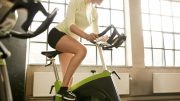
The team’s research reveals a more effective method to determine each person’s workout intensity for the best outcomes.
Using something known as ‘critical power,’ the team hopes to develop exercise prescriptions.
Anyone who frequently exercises is familiar with the phenomenon wherein two individuals with comparable levels of fitness may do the same exercise and have vastly different outcomes. It’s extremely frustrating for individuals who can’t seem to progress despite their best efforts.
Exercise science researchers at Brigham Young University have tried to address the issue since they are familiar with the feeling. Good news: they think they’ve figured out the code.
The team’s recently released study reveals a more practical method for figuring out the level of intensity that each individual should exercise to get the best results. A study published in the Journal of Applied Physiology describes a new system for creating “prescribed” workouts that provide results regardless of an individual’s current health.
“One day we’ll get to prescribe exercise-like medicine,” said Jayson Gifford, BYU exercise science professor and senior author of the study. “In order to prescribe medicine, you need to have predictable results for each dosage of medicine. We’ve found the exact same thing applies to exercise.”
According to the study, exercise that is personally prescribed based on what is known as “critical power” produces greater improvements in endurance and longer-lasting benefits for the individual. The authors define critical power as the highest level of our comfort zone. “It’s the level at which we can perform for a long period of time before things start to get uncomfortable,” said study lead author Jessica Collins, a former BYU graduate student.
It works something like this: Assume two friends have the same Max Heart Rate. Previous knowledge of exercise would imply that if they together ran at the same pace, they should have very similar experiences. However, it so happens that when these two friends run at 6 mph, the exercise is simple for one but tough for the other. These disparities in experiences at the same speed and percentage of Max Heart Rate are due to the fact that 6 mph is below one friend’s critical power but over the other’s critical power.
When exercise is below a person’s critical power, their body can compensate for the energy challenge and reach a comfortable and controlled homeostasis. However, when exercise is above one’s critical power, the body cannot completely compensate for the energy demand, resulting in exhaustion.
Traditionally, individualized exercise has been recommended based on a fixed percentage of one’s maximum rate of oxygen consumption (VO2 Max) or their Max Heart Rate. Collins and Gifford said using “critical power” is a better way of prescribing exercise because it not only accurately serves athletes and those in great shape, but it also serves those who are older or have a more sedentary lifestyle.
“This kind of research helps every kind of person, no matter how active they presently are,” Collins said.
For the study, Collins, Gifford, and coauthors recruited 22 participants between the ages of 18-35 who were healthy but exhibited low fitness levels. Participants underwent eight weeks of supervised exercise training where they were randomly assigned to either high-intensity bike training or moderate-intensity continuous bike training. Exercises were prescribed traditionally based on an individual’s max heart rate or VO2 Max.
Researchers discovered that prescribing exercises based on VO2 Max as a reference point results in alarming variability in results. There were participants who benefited significantly from the training period and others who did not, even though the training was personalized to them. They compared this to each individual’s critical power and found that it accounted for 60% of the variability in their findings. If exercises had been prescribed using critical power as a reference point versus their heart rate, the results would have varied less, meaning the training sessions would have been more effective and beneficial for each participant.
“One of the biggest reasons people don’t exercise as much as they should is because they tried something in the past, and it didn’t work out the way they were expecting it to,” Collins said. “The great thing about basing exercises on critical power is that we can almost always guarantee the result, which allows us to help people to achieve their fitness goals.”
To calculate a person’s critical power, researchers had participants complete multiple distances of exercise (i.e. running, biking) as fast as they could. They then took the average speed and inserted that data into a proprietary formula that determines the relationship between exercise distance and exercise time to produce a critical power number. They found a person’s critical power can increase substantially with exercise training, making things that used to be hard less challenging, less uncomfortable, and less fatiguing.
“Exercise is so good for you that you’ll see some sort of benefit no matter what you do,” Gifford said. “This research simply informs people that they can more fully optimize their exercise, so they get more out of it. We are excited for when it becomes more accessible for people to know their personal critical power in the near future.”
Reference: “Critical power and work-prime account for variability in endurance training adaptations not captured by V̇o2max” by Jessica Collins, Olivia Leach, Abigail Dorff, Jessica Linde, Jason Kofoed, Megan Sherman, Meagan Proffit and Jayson R. Gifford, 6 October 2022, Journal of Applied Physiology.
DOI: 10.1152/japplphysiol.00344.2022









It will help some people to start making exercise apart of their life it will change mindsets
I don’t normally comment on articles, but this one hits close to home.
While this might be interesting for some people, and I’m sure BYU spent their resources wisely on this study, the athletic community has already been doing this for decades.
Cyclists use power meter to measure their output, allowing their trainers and coaches to create custom workout plans.
Runners have been using ‘power meter’ foot power pods for at least ten years, and the latest batch of sports watches support native running power measurements.
I won’t mention any brand names, but there are now many brands involved with training by power, and they all offer customized training plans. Most athletes find this very useful and surprisingly accurate.
Of course, there are many ways to approach training: Heart Rate, Power, Pace, Perceived Effort, etc. Critical Power has been found by many (not all) endurance athletes to be helpful in their training.
The biggest concern I have with this article and the study it discusses, is that they seem to think they’re ‘on to’ something new; something that can be prescribed like a medicine.
While exercise is great for health, no one who currently doesn’t exercise is going to suddenly train on Critical Power just because it’s “prescribed”.
Just in case anyone reads this article and my comment, please know this is nothing new, and do your research first. There are many, many resources available. 🙂